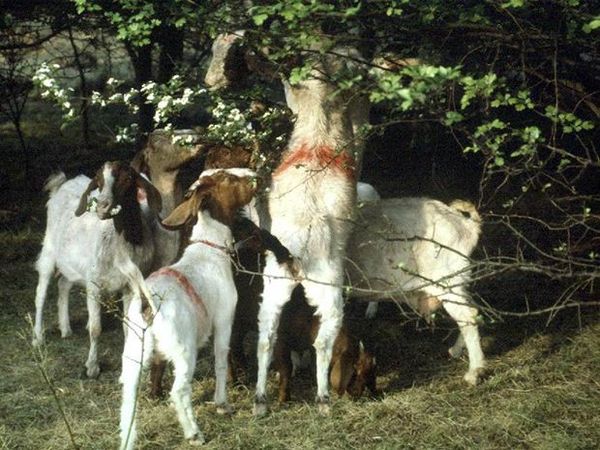Expertise
The goat as gardener - biotope maintenance with goats
Gerold Rahmann | 02.06.2022
They like to bite woody plants, do not even stop at thorny undergrowth and can graze leaves standing on their hind legs if necessary - the goat is excellently suited for maintaining biotopes and keeping valuable open areas free.
The use of goats in biotope maintenance has gained in importance in recent years, especially on rough grasslands. As part of a flock of sheep or on their own, they are mainly intended to help control woody growth and also to push back scrub encroachment. More than any other farm animal species in Germany, goats can obtain a large part of their nutrition from leaves and bark. They like to climb and can therefore also be used in terrain where machines and other farm animals reach their limits. In addition, their unusual feeding behaviour - they can stand on two legs if necessary (facultative bipedality) - allows them to reach foliage in higher regions that are inaccessible to sheep. In addition, their split upper lip allows the goats to pick out food selectively. Thus they can also graze on thorny bushes.
Goats love leaves and bark of woody plants. Only some spurn them, but otherwise they can cover up to 60 % of their diet with foliage. In nature conservation, they can therefore be used well for bush clearance; the woody forage is also highly species-appropriate. It would therefore be desirable if dairy goats were also offered foliage feed, but most pastures have no woody plants, and feeding them in the barn is too labour-intensive. However, so far there is little knowledge about the feed value and the effect of foliage on the products, about the best possible availability of foliage (for example as fodder hedges) and about which woody plants are best suited. We investigated these questions at the Thünen Institute of Organic Agriculture with woody plant studies and fodder hedges for goats.
Important results and recommendations
- Goats can be used to clear areas that are up to 60 % overgrown.
- Fencing should be done with strands that normally prevent the goats from escaping, but allow them to break free in an emergency. The fence should have a cap voltage of around 6000 volts.
- Meat breeds (Boer goat, crossbred Boer x dairy breed) should be used in biotope management. Purebred dairy goats do not find enough feed and their udders are at risk of injury.
- Suckling lambs should be kept; the lambs achieve daily gains of 100 to 150 grams during biotope maintenance.
- De-bushing with goats can significantly reduce the costs of biotope maintenance (50 to 75 %).
- The maintenance premiums must cover the lost income from meat goat husbandry (around 350 euros per hectare).
- The removal of shrubs from a scrubby area takes about three to five years with goats.
- Goats alone can push back bushes, but not eliminate them. Manual maintenance must provide support (about ten hours per hectare per year of additional brush-cutting work).
- The health of goats is at risk on biotopes. Endoparasite pressure must be controlled so that the animals do not suffer. Shelter must be offered against inclement weather.





